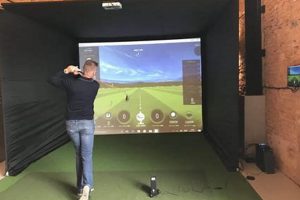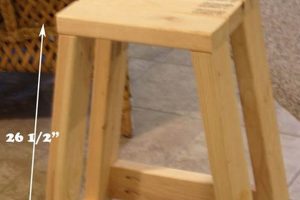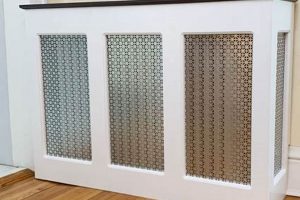A self-constructed gaming enclosure replicates the classic upright video game consoles found in amusement centers. Such projects typically involve assembling a wooden structure, integrating a monitor, installing game controls (joystick, buttons), and configuring a software platform to emulate classic arcade games. A popular example includes building a cabinet from readily available lumber, wiring buttons to a Raspberry Pi, and loading a RetroPie image for gaming.
This approach to retro gaming offers significant advantages, including cost savings compared to purchasing a pre-built unit. It also provides customization options in terms of cabinet design, control layout, and game selection, allowing enthusiasts to tailor the experience to their specific preferences. The history of home-built game systems dates back to the early days of computing, but the availability of affordable microcomputers and open-source software has greatly simplified the process, fueling a resurgence in popularity.
The subsequent sections will address various aspects of constructing such a system. This includes selecting appropriate materials, understanding fundamental construction techniques, choosing the optimal software and hardware components, and troubleshooting common challenges encountered during the build process.
Tips for Constructing a Self-Made Gaming Enclosure
The following are key considerations for achieving a successful construction and optimal functionality.
Tip 1: Material Selection: Medium-density fiberboard (MDF) offers a smooth surface for painting and vinyl graphics, but requires careful sealing to prevent moisture damage. Plywood provides superior structural strength and resistance to warping, particularly important for larger cabinets.
Tip 2: Precise Measurements: Accurate measurements are paramount for a stable and aesthetically pleasing finished product. Double-check all dimensions before cutting materials, accounting for the thickness of the chosen material.
Tip 3: Ergonomic Control Layout: Prioritize player comfort by researching standard arcade control layouts. Consider the size of the hands that will use the controls. A well-planned layout minimizes strain and maximizes gameplay enjoyment.
Tip 4: Secure Component Mounting: Employ robust mounting solutions for the monitor, controls, and internal electronics. Screws, bolts, and specialized brackets will ensure components remain securely fastened during use and transportation.
Tip 5: Effective Ventilation: Heat generated by the monitor and electronics can damage components over time. Incorporate ventilation openings and, if necessary, cooling fans to dissipate heat effectively.
Tip 6: Comprehensive Wiring: Label all wires clearly to facilitate troubleshooting and future modifications. Consider using a wiring harness or breakout board to simplify connections between controls and the control interface.
Tip 7: Software Configuration: Research different emulation platforms (RetroPie, Recalbox) and choose one that meets specific needs. Spend time configuring the software to optimize performance and customize the user interface.
Tip 8: Thorough Testing: Before final assembly, thoroughly test all components and connections. This includes verifying that all buttons and joystick directions are functioning correctly and that the monitor displays a clear image.
Adherence to these guidelines enhances the quality, longevity, and playability of a custom-built gaming enclosure. Attention to detail during each phase of construction is crucial for a satisfying and functional outcome.
The subsequent sections will delve into specific aspects of troubleshooting common issues and exploring advanced customization options.
1. Cabinet Dimensions
Cabinet dimensions directly influence the ergonomics, aesthetics, and practicality of a self-constructed gaming enclosure. As a foundational element of this project, these dimensions determine the overall footprint, thereby dictating the space required for its placement. Furthermore, they affect the internal volume available for accommodating components such as the monitor, control panel, and associated electronics. An improperly sized cabinet compromises gameplay due to cramped control layouts or obstructed viewing angles. Conversely, overly large dimensions can render the unit unwieldy and visually disproportionate. The dimensions must, therefore, be carefully considered relative to the target user and the available space.
The selection of dimensions has cascading effects on other design choices. The size of the monitor is constrained by the width of the cabinet, impacting resolution and visual clarity. Similarly, the control panel’s dimensions are dictated by the cabinet’s width and depth, influencing the number and arrangement of buttons and joysticks. In a real-world example, a cabinet designed to replicate the dimensions of a classic Pac-Man machine necessitates a specific width and depth to accommodate a 19-inch CRT monitor and a single-player control panel. Deviations from these dimensions would compromise the authenticity and playability of the recreation. Additionally, dimensions influence the structural integrity of the cabinet, requiring thicker materials for larger units to prevent warping or collapse. Careful consideration must also be given to the dimensions as they relate to shipping, moving, or transporting the completed cabinet.
In summary, the dimensions serve as a critical starting point in the design process, profoundly affecting every aspect of the final product. Ignoring the importance of precise and well-considered dimensions can lead to a structurally unsound, ergonomically flawed, and ultimately unsatisfactory self-constructed gaming enclosure. The selection process necessitates a balance between desired aesthetics, functional requirements, and practical limitations.
2. Control Interface
The control interface represents the primary means of user interaction within a self-made gaming enclosure. Its design and implementation critically impact gameplay experience, determining the accuracy, responsiveness, and overall enjoyment derived from the system. The careful selection and configuration of components within this interface are therefore paramount to a successful outcome.
- Component Selection: Joysticks
Joysticks translate physical movements into digital signals for game control. They vary in construction, ranging from micro-switch based designs offering tactile feedback and durability, to analog joysticks providing greater sensitivity for nuanced control. The choice of joystick influences gameplay precision in different genres. For instance, an octagonal-gated joystick provides distinct directional feedback suited for fighting games, while a smooth, circular-gated joystick is often preferred for games requiring free-flowing movement. San
wa and Seimitsu are industry-recognized joystick manufacturers with distinct qualities favored in different gaming communities. - Component Selection: Buttons
Arcade buttons serve as the activation points for in-game actions, requiring responsiveness and durability. Similar to joysticks, buttons are typically based on micro-switch technology. Convex and concave button profiles offer different tactile sensations, while the activation force required by the micro-switch affects responsiveness. The spacing and layout of buttons must align with ergonomic principles to minimize user fatigue and maximize efficiency. Proper wiring of buttons to a control interface is essential for their functionality. This usually involves connecting each button to a dedicated input on a microcontroller board that translates button presses into digital signals.
- Control Interface Hardware: Encoders
Encoders act as the bridge between physical controls (joysticks and buttons) and the computer or gaming system running the emulation software. These devices convert button presses and joystick movements into digital signals that the system can interpret. Common encoder options include USB encoders, which offer plug-and-play compatibility with PCs and Raspberry Pi systems. Zero Delay USB encoders minimize input lag, enhancing responsiveness, whereas specialized encoders like the Brook Fighting Board are designed for tournament-grade fighting game experiences, offering advanced features such as SOCD cleaning.
- Software Configuration: Mapping and Calibration
Software configuration is crucial for mapping physical controls to in-game actions and calibrating joystick sensitivity. Emulation platforms such as RetroPie and MAME provide tools for assigning button and joystick inputs to specific functions within each game. Calibration ensures that the full range of joystick movement is accurately translated into in-game actions, preventing dead zones or inaccurate responses. Precise configuration optimizes the user experience and ensures that controls function as intended.
The interplay of these components, from the tactile feel of the buttons to the precision of the joystick and the functionality of the encoder, contributes directly to the immersive quality of a self-made gaming enclosure. A thoughtfully designed and meticulously implemented control interface not only enhances the gameplay experience but also contributes significantly to the overall value and enjoyment derived from the project. Each element impacts the user experience.
3. Display Integration
Display integration constitutes a pivotal aspect in the construction of a self-assembled gaming enclosure. The selected display directly influences visual fidelity, viewing angles, and the overall aesthetic appeal of the finished unit. Choices in display technology must align with budgetary constraints, available space, and intended gaming experience.
- Display Type: CRT vs. LCD
Cathode Ray Tube (CRT) monitors provide authentic retro visuals with inherent scanlines and accurate color reproduction, particularly desirable for older arcade games. However, CRTs are bulky, heavy, and consume more power than modern alternatives. Liquid Crystal Display (LCD) monitors offer higher resolutions, lighter weight, and lower power consumption. LCDs lack the inherent scanlines of CRTs, potentially affecting the visual authenticity of retro games, although scanline generator hardware and software can simulate this effect. Selection between CRT and LCD necessitates balancing authenticity with practicality.
- Display Size and Aspect Ratio
The physical size of the display must conform to the internal dimensions of the cabinet, influencing viewing distance and overall ergonomics. A 19-inch display represents a common choice for single-player cabinets, while larger displays (25-27 inches) can accommodate two-player setups. The aspect ratio is important when playing games optimized for older screens. 4:3 (standard) for classic games and 16:9 (widescreen) for modern games. Mismatched aspect ratios require either stretching or cropping the image, potentially distorting the visual presentation.
- Resolution and Refresh Rate
Resolution dictates the level of detail visible on the screen. Higher resolutions provide sharper images, but may not be necessary for older games designed for lower resolutions. The refresh rate, measured in Hertz (Hz), determines how many times per second the image is updated. Higher refresh rates reduce motion blur and improve visual clarity, particularly important for fast-paced action games. Aim for a refresh rate that is at least 60 Hz, although higher refresh rates (120 Hz or 144 Hz) can further enhance the visual experience.
- Connectivity and Signal Conversion
Ensuring compatibility between the display and the gaming system requires careful consideration of connectivity options. Modern displays typically offer HDMI, DisplayPort, and VGA inputs. Legacy gaming systems may output video signals through composite video, S-Video, or component video connections. Signal converters may be necessary to bridge the gap between these different standards. For example, connecting a classic arcade board with a JAMMA connector to an HDMI display requires a JAMMA-to-HDMI converter board. Selection of converters should prioritize minimal latency to avoid input lag.
The successful integration of the display into a self-made gaming enclosure hinges on careful planning and execution. The selection of an appropriate display type, size, resolution, and connectivity options contribute directly to the visual fidelity, playability, and overall enjoyment derived from the project. Thoughtful display integration enhances the gaming experience. Selecting the proper connection cables and converters should also be part of the cabinet build and design.
4. Emulation Software
Emulation software constitutes a core component in most self-constructed arcade cabinets, enabling the execution of legacy arcade game software on modern hardware. Its selection and configuration directly influence game compatibility, performance, and user experience.
- ROM Management and Acquisition
Emulation software relies on ROMs (Read-Only Memory) files, which contain the game data extracted from original arcade boards. Acquiring ROMs legally often involves owning the original arcade hardware. Illegally distributing or downloading copyrighted ROMs violates copyright laws. Proper ROM management involves organizing files, verifying checksums to ensure data integrity, and adhering to legal and ethical guidelines regarding ROM acquisition. The success of a gaming cabinet hinges on its ROMs.
- Emulation Platforms: MAME and RetroArch
MAME (Multiple Arcade Machine Emulator) is a widely used emulator focused on accuracy and preserving original arcade game behavior. RetroArch is a frontend capable of running multiple emulation cores, including MAME, offering a unified interface and cross-platform compatibility. MAME prioritizes emulation accuracy and requires powerful hardware for optimal performance, while RetroArch prioritizes flexibility and can run on lower-powered devices like Raspberry Pi. Choosing the right platform depends on the desired balance between accuracy, performance, and ea
se of use. - Configuration and Customization
Emulation software necessitates configuration to optimize performance, map controls, and customize visual settings. Configuration files allow modification of CPU clock speeds, display resolution, and other parameters. Control mapping assigns physical buttons and joysticks to in-game actions. Customization options include applying shaders to simulate CRT effects, configuring audio settings, and creating custom menu systems. Effective configuration improves responsiveness and enhances the visual and auditory experience.
- Performance Optimization and Hardware Requirements
Achieving optimal performance requires careful consideration of hardware requirements and software optimization techniques. Emulation can be resource-intensive, particularly for newer or more complex arcade games. CPU speed, RAM capacity, and graphics processing power influence emulation performance. Optimization techniques include adjusting emulator settings, selecting appropriate video drivers, and overclocking the hardware. Insufficient hardware or unoptimized settings can result in stuttering, slowdown, and unplayable framerates.
These points underscore the critical role of emulation software in delivering a functional and enjoyable experience on a self-made arcade cabinet. Proper selection, configuration, and management of emulation software, ROMs, and associated hardware directly determine the success or failure of the project. A fully optimized platform requires a balance between hardware capability and software application.
5. Aesthetic Design
The aesthetic design of a self-constructed gaming enclosure significantly influences its visual appeal and integration into a living space. While functionality remains paramount, the visual presentation contributes to the overall user experience and the perceived value of the project. The design choices reflect the builder’s personal style and can range from faithful recreations of classic arcade cabinets to entirely original and modern interpretations. The selection of materials, colors, artwork, and lighting all contribute to the enclosure’s aesthetic identity.
The impact of aesthetic design extends beyond mere visual appeal. A well-designed cabinet can serve as a conversation piece and a focal point in a room. Conversely, a poorly executed design can detract from the surrounding environment. Examples of successful aesthetic integration include cabinets finished with wood veneers and subtle lighting to complement existing furniture, or cabinets adorned with custom artwork that reflects personal interests or pays homage to classic games. Consideration of ergonomic factors, such as control panel height and viewing angle, also impacts the aesthetic perception of the unit, as a comfortable and user-friendly design contributes to its overall appeal. Furthermore, lighting options can drastically change the aesthetics. Illuminated buttons or LED strips around the edges of the cabinet make it stand out.
In conclusion, the aesthetic design of a self-made gaming enclosure represents a critical element in the overall project. It is not simply an afterthought but an integral component that influences both the user experience and the integration of the unit into its surroundings. Careful attention to detail in material selection, color schemes, artwork, and lighting results in a visually appealing and personally satisfying creation. The appearance enhances the project, and should be a critical step to consider for any project.
Frequently Asked Questions
The following addresses common inquiries regarding the construction and operation of self-made gaming enclosures, providing factual information and guidance.
Question 1: What is the typical cost associated with constructing a gaming enclosure from scratch?
The expense varies considerably based on material choices, component selection, and the complexity of the design. A basic unit, utilizing readily available materials and a Raspberry Pi-based system, may cost between $200 and $400. More elaborate constructions, incorporating high-end components and custom artwork, can exceed $1000.
Question 2: What are the essential tools required for building this unit?
Fundamental tools include a circular saw or jigsaw for cutting wood, a drill for creating pilot holes and mounting components, a screwdriver set, a measuring tape, a square, and a soldering iron for electrical connections. Additional tools, such as a router, may be required for more complex designs.
Question 3: What is the recommended material for constructing the cabinet?
Medium-density fiberboard (MDF) and plywood represent common choices. MDF offers a smooth surface for painting and applying graphics but is susceptible to moisture damage. Plywood provides greater structural strength and resistance to warping, particularly suitable for larger enclosures.
Question 4: What are the primary considerations when selecting a monitor for integration?
Key factors include resolution, aspect ratio, viewing angle, and connectivity options. LCD monitors offer a balance of image quality and affordability, while CRT monitors provide a more authentic retro gaming experience. The monitor’s size must correspond to the cabinet’s internal dimensions.
Question 5: What is the best approach for configuring the control interface?
A USB encoder represents a common solution for connecting arcade controls to a computer or Raspberry Pi. This device translates button presses and joystick movements into digital signals. Software configuration within the emulation platform allows mapping of controls to specific in-game actions.
Question 6: How does one legally acquire ROMs for use with emulation software?
The legally permissible method involves extracting ROMs from original arcade boards owned by the user. Downloading or distributing copyrighted ROMs from unauthorized sources constitutes copyright infringement. Open-source or public domain games represent exceptions, as their distribution is typically permitted.
In summary, the construction of a self-made gaming enclosure requires careful planning, appropriate tools, and a commitment to both functionality and legal compliance. Informed decision-making at each stage ensures a satisfactory outcome.
The subsequent section will explore advanced customization techniques and troubleshooting strategies for resolving common issues.
Conclusion
The preceding sections have detailed the diverse elements involved in the creation of a gaming enclosure built by the user. From the initial planning stages concerning dimensions and material selection, to the intricate steps of control interface implementation and display integration, each phase demands careful consideration. The selection of emulation software and the subsequent ROM management are also critical components for a successful and legally compliant outcome. Attention to aesthetic details further enhances the overall appeal of the project.
The information provided should serve as a foundation for prospective builders embarking on their own projects. Success hinges on a blend of technical skill, meticulous planning, and adherence to both legal and ethical considerations. Further exploration of advanced customization techniques and troubleshooting methods will refine the building process, thereby resulting in a functional and aesthetically pleasing gaming enclosure that is built by yourself.
e>







